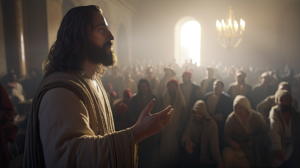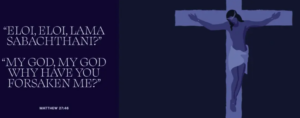


If we have hoped in Christ only in this life, we are of all people most to be pitied
1 Cor 15:19 (NASB)
Article By: Nathan W. Hoff
Based on the Four Biblical Gospel’s Account of Jesus Christ’s Resurrection
Matthew – Mark – Luke – John
Written: March 31, 2025
Published Online: April 2, 2025
Eternal Hope in the Resurrection of Jesus Christ
As humans we have an undeniable need for HOPE… In the Western world planning our lives for future benefits or achievements seems second nature. This planning of our “future better lives” is another way of saying WE HOPE that in the future these things are true.
Introduction
God created humanity perfect and for a time Adam and Eve lived in perfect harmony with God. God provided food from every tree in their garden. There was one exception – they could not eat from the Tree of Knowledge (Gen 2:16-17). However, Genesis 3:6 explains that they sinned against God’s command and ate from the Tree of Knowledge.
It was at this point that humanity required a Savior; as all future generations of humanity had been instantly separated from God through Adam’s sin (Romans 5:12-21). Humanity required a path to reconciliation with God the Father but had no way to settle the sin debt on their own – God the Father offered grace in the form of His Son Jesus Christ’s death upon the cross – upon Christ’s death His shed blood wiped away the sin debt for those who accept Christ as their Savior –– the faithful in Christ have a great hope of an eternal life through Christ because of His resurrection we can expect to also be resurrected in the spiritual realm; the sin of Adam cannot separate Christians from an eternal life with Jesus Christ.
1 Peter 1:3-8 states:
3 Blessed be the God and Father of our Lord Jesus Christ, who according to His great mercy has caused us to be born again to a living hope through the resurrection of Jesus Christ from the dead, 4 to obtain an inheritance which is imperishable, undefiled, and will not fade away, reserved in heaven for you, 5 who are protected by the power of God through faith for a salvation ready to be revealed in the last time. 6 In this you greatly rejoice, even though now for a little while, if necessary, you have been distressed by various [a]trials, 7 so that the [b]proof of your faith, being more precious than gold which perishes though tested by fire, may be found to result in praise, glory, and honor at the revelation of Jesus Christ.
This article will analyze the Christian’s great hope through Christ’s resurrection. The facts of the Bible states that Jesus was sacrificed for the sinner via crucifixion and resurrected on the third day.
The Christian’s Great Hope
Through one’s life there is great hope and expectation of a great reward – an expected outcome. Rather that reward is graduating high school, university, the dream job, or marriage and family. All people have some version of hope for a future “better existence”.
The same is true for followers of Christ – there is a great hope in a future “better existence”. For Christians that “better existence” is an eternal existence in Christ in both the living world as well as in the spiritual realm. The Bible states that Jesus died…He did not simply pass out or suffer a medical mystery of appearing dead while still being alive…He died on the cross. The Bible also stresses through eyewitness evidence that Jesus Christ was resurrected from the grave on the third day. Christ’s resurrection is the main tenet of Christianity and His resurrection is required for Christianity to be “valid”.
History of Crucifixion
As Christians it is important that we present as much legitimate evidence as possible to support the literal historical accounts documented within the Scriptures. Although, the Scriptures in their original manuscripts are “inerrant” and “infallible” (without error and completely trustworthy) secular society seems to only recognize truth from non-Christian sources. Therefore, to present from a secular source helps level the field when attempting to present the shameful torture Jesus Christ went through upon that Roman cross.
In the Abstract article below — All credit is given to the author(s) of this original work as sited in the references. No changes have been made to this article to include spelling.
Abstract
In antiquity crucifixion was considered one of the most brutal and shameful modes of death. Probably originating with the Assyrians and Babylonians, it was used systematically by the Persians in the 6th century BC. Alexander the Great brought it from there to the eastern Mediterranean countries in the 4th century BC, and the Phoenicians introduced it to Rome in the 3rd century BC. It was virtually never used in pre-Hellenic Greece. The Romans perfected crucifion for 500 years until it was abolished by Constantine I in the 4th century AD. Crucifixion in Roman times was applied mostly to slaves, disgraced soldiers, Christians and foreigners–only very rarely to Roman citizens.
Death, usually after 6 hours–4 days, was due to multifactorial pathology: after-effects of compulsory scourging and maiming, haemorrhage and dehydration causing hypovolaemic shock and pain, but the most important factor was progressive asphyxia caused by impairment of respiratory movement. Resultant anoxaemia exaggerated hypovolaemic shock. Death was probably commonly precipitated by cardiac arrest, caused by vasovagal reflexes, initiated inter alia by severe anoxaemia, severe pain, body blows and breaking of the large bones.
The attending Roman guards could only leave the site after the victim had died, and were known to precipitate death by means of deliberate fracturing of the tibia and/or fibula, spear stab wounds into the heart, sharp blows to the front of the chest, or a smoking fire built at the foot of the cross to asphyxiate the victim.[1]
[1] Retief, F. P., and L. Cilliers. 2003. “The History and Pathology of Crucifixion.” South African Medical Journal = Suid-Afrikaanse Tydskrif Vir Geneeskunde 93 (12): 938–41. https://pubmed.ncbi.nlm.nih.gov/14750495/.
The following is how the Romans nailed hands and feet to the cross (fig 4 & 5). Crucifixion would affect one’s breathing (fig 6).
Fig 4.–Nailing of wrists.
Left. Size of iron nail. Center. Location of nail in wrist, between carpals and radius. Right. Cross section of wrist, at level of plane indicated at left, showing path of nail, with probable transection of median nerve and impalement of flexor pollicis tongus, but without injury to major arterial trunks and without fractures of bones.
Fig 5.–Nailing of feet.
Left. Position of feet atop one another and against stipes. Upper right. Location of nail in second intermetatarsal space. Lower right. Cross section of foot, at plane indicated at left, showing path of nail.
Fig 6.–Respirations during crucifixion.
Left. Inhalation. With elbows extended and shoulders abducted, respiratory muscles of inhalation are passively stretched and thorax is expanded. Right. Exhalation. With elbows flexed and shoulders abducted and with weight of body on nailed feet, exhalation is accomplished as an active, rather than passive, process. Breaking legs below the knees would place burden of exhalation on shoulder and arm muscles alone and soon would result in exhaustion and asphyxia.
Source for images & comments: http://www.champs-of-truth.com/lessons/tract_13g.htm
All credit for these images and statements concerning the nailing hands (wrist) and feet and breathing affects is solely the author of the source document.
Used on this site only as a reference.
Christ’s Crucifixion Outlined in the Gospels
The Biblical Gospels document well the torture and killing of Jesus Christ and His resurrection. Other non-biblical authors wrote about Jesus, such as the “Annals,” of Tacitus, Josephus, a Jewish-Roman historian, in his “Antiquities of the Jews,” both spoke of Jesus and alluded to Jesus’s followers’ faith in His resurrection without using the word resurrection which only strengthens the argument for Jesus’s resurrection – for if Jesus had not been resurrected men such as these would have certainly documented the fact that Jesus failed at being what He said He was…God.
The Biblical Gospels outline the crucial moments of Jesus’s prosecution and His crucifixion upon a Roman cross.

Jesus’s Crucifixion by the Ancient Jewish Timeclock

The ancient world including the Jewish nation had not adopted the use of modern time as we know it today. Nor did the Jewish nation understand a full day to mean from 12 am – 12 am. Instead, the Jewish understanding of a day began and ended at sunset. In the biblical gospels account of Jesus’s crucifixion, they record three particular times which are important to understand. These include the third hour, the sixth hour, and the ninth hour.
Mark 15:25 identifies that Jesus was crucified at the third hour – we know that the Jewish day began at sunset however, it was at sun rise that they would begin to count the hours. So, the first hour is 6 am and the third hour is at 9 am. Mark continues in Mark 15:33 telling the read that a darkness fell upon the earth from the sixth hour until the ninth hour. Using ancient Jewish time counting this sixth hour is 12 pm (noon) and the ninth hour is 3 pm.
Mark 15:33-37 records the events of the ninth hour with Jesus’s statement, “Eloi, Eloi, lema sabaktanei?” which is translated, “My God, My God, why have You forsaken Me?” Then He let out a loud cry and died upon the cross at the ninth hour (3 pm).
With this ancient timeclock we can decipher that Jesus was placed on the cross at 9 am until 3 pm or shortly thereafter (as the Jewish leaders wanted the dead removed before the Sabbath). Mark 15:42-46 testifies to the removal of Jesus’s body.
Accused and Placed on a Roman Cross
Only hours before Jesus had celebrated the Lord’s Supper with His disciples in the upper room. Shortly, thereafter Jesus emotionally prayed in the garden of Gethsemane-it was here He was betrayed by His disciple Judas. These events were followed by the false accusations from the Jewish religious leaders against Jesus and the release of a notorious prisoner Barabbas instead of freeing the innocent Jesus. Pilate released Jesus into the hands of the religious leaders as he could find no wrongdoing – Pilate had Jesus flogged and later the Jewish leaders had Jesus crucified upon a Roman cross.
A sign was placed on top of Jesus’s cross which was written, ““THIS IS JESUS THE KING OF THE JEWS.” This was the charge placed against Jesus by Pilate.
Jesus’s last words at the ninth hour (3 pm) on the cross are recorded in the Gospels of Matthew 27 and Mark15 as:
“Eloi, Eloi, lema sabaktanei?” which is translated, “My God, My God, why have You forsaken Me?”
Mark 15:37-38 records the last moments of Jesus’s life he writes, “But Jesus let out a loud cry, and [x]died. And the veil of the temple was torn in two from top to bottom.
Death Upon a Cross – Pierced with a Spear
31 Now then, since it was the day of preparation, to prevent the bodies from remaining on the cross on the Sabbath ([a] for that Sabbath was a high day), the Jews requested of Pilate that their legs be broken, and the bodies be taken away. 32 So the soldiers came and broke the legs of the first man, and of the other who was crucified with Him; 33 but after they came to Jesus, when they saw that He was already dead, they did not break His legs. 34 Yet one of the soldiers pierced His side with a spear, and immediately blood and water came out. 35 And he who has seen has testified, and his testimony is true; and he knows that he is telling the truth, so that you also may believe. 36 For these things took place so that the Scripture would be fulfilled: “Not a bone of Him shall be [b]broken.” 37 And again another Scripture says, “They will look at Him whom they pierced.”
31a – Sabbath in verse 31 literally means for the day of that Sabbath – referring to the coming Sabbath as a special Sabbath.
36b – Broken in verse 36 is also translated crushed; or shattered.
Christ and the two crucified with Him were taken down from their crosses – however, before removing them from their crosses the Romans broke the legs of the two thieves ensuring their speedy death. When the Romans saw that Jesus was already dead on the cross, they did not break His legs as it was not needed since He was already dead.
So, why did the Roman soldier pierce Jesus’s side as documented in John 19:34? As confirmed by Roman tradition it was an act of confirming the death of Christ although He appeared to be dead. However, it most definitely also was to fulfill biblical prophecy – known as the messianic prophecy as noted in Isaiah 53:5 which states, “But He was pierced for our offenses.” The piercing of the spear is yet another sign pointing to Jesus as the Jewish Messiah, “anointed one”.
(A perfect example of God’s providence – using humanity to fulfill His plan.)
Jesus’s Burial
The Jewish Sabbath was upon the nation of Isreal – Jesus was laid in the tomb of a rich man named Joseph of Arimathea. It so happens that Mark 15:43 tells us that Joseph of Arimathea was a prominent member of the Council. This council refers to the Sanhedrin, the Jewish Council in Jerusalem.
Biblestudytools.com explains the Sanhedrin as, “The Sanhedrin was, at and before the time of Christ, the name for the highest Jewish tribunal, of 71 members, in Jerusalem.”[1] Therefore, we can reason that Joseph of Arimathea was not only a rich man but a powerful Jewish leader. Mark 15:43 also exposes Joseph of Arimathea as, “Who was himself also waiting for the kingdom of God.”
The Bible reveals that the rich man who laid Jesus in the tomb was also a believer in Jesus Christ. This is a point not often made and too often is skimmed over by readers. Just as Christians do today Joseph of Arimathea, also hoped for a future life in God’s kingdom.
Two known witnesses watch as Jesus was laid in the tomb by Joseph of Arimathea. Mark 15:47 states, “Mary Magdalene and Mary the mother of Joses were watching to see where He was laid.” We also know by Scripture that Jesus was wrapped in linen cloth by Joseph of Arimathea – who also had a large stone placed in front of the tomb’s entrance (Mark 15:46).
[1] “Sanhedrin Meaning – Bible Definition and References.” 2025. Bible Study Tools. 2025. https://www.biblestudytools.com/dictionary/sanhedrin/.
In the Tomb Three Days and Three Nights

While being pressured for a sign by the Jewish religious scholars, Jesus, foretold of His pending time in the grave for three days and three nights. Jesus’s timeline prophecy mirrored the Old Testament story of Jonah, which is somewhat an indirect foreshadowing of the death and resurrection of the Messiah.
In Matthew 12:38-40 Jesus, Himself discloses to the Jewish Scribes and Pharisees that He will be in the grave (heart of the earth) for three days and three nights. Since these were Jewish religious scholars His example which He provided was the familiar Old Testament event of Jonah in the sea creature for three days and nights. As with Jonah who came out of the sea creature’s stomach on the third day so Christ would leave the heart of the earth (grave) on the third day – this is the resurrection of Jesus Christ.
The following are the biblical references from the New Testament Gospels concerning the statement about Jesus being in the grave for three days and three nights.
Matthew 12:40 “For 3 days and 3 Nights”
John 2:19 “In 3 Days”
Mark 8:31 “After 3 Days”
Luke 24:46 “The 3rd Day”
From Resurrection Comes Eternal Hope
Because Jesus Christ was resurrected on the third day from the tomb; those who have accepted Jesus as their Savior can expect:
- Once they pass into the spirit world
- They will live with Christ forever
- They will never suffer eternal death which separates from God the Father
Christians because of their Savior’s resurrection will have a great HOPE in a future “better existence”. This “better existence” is immediate once Christians pass into the spirit world. For Christians that “better existence” is an eternal existence in Christ. This means that believers in Jesus Christ as their Savior will never suffer in death and will never be separated from God in death for all of eternity.
This is the eternal HOPE spoken about in Hebrews 6:19-20 and 1 Corinthians 15:19.
In Hebrews 6:19-20 the Apostle Paul, speaks to the HOPE that the believer’s soul has for its future existence based on Jesus having first gone through death and later resurrection. As believers we are assured our soul will be with Christ.
In 1 Corinthians 15 the Apostle Paul, outlines the “Facts of Jesus’s Resurrection” – he logically discusses how and why the resurrection is true. In 1 Corinthians 15:19 Paul, reenforces that a Christian’s HOPE should:
Not only be in Christ during this life while we are alive on earth but, this same HOPE which we have while living should also be the HOPE for the afterworld of the spirit once we have passed-on.
In other words, Jesus died. He then was resurrected – we too will die and in the same manner we will be resurrected in spirit to be with Jesus forever.
Resurrection = Eternal Hope
The death and resurrection of Jesus Christ from the grave gifts the repentant sinner eternal life. One of two Greek words for life is Zoe (zōēs) which is the word used to describe life as spoken of in John 6:68, “Simon Peter answered Him, “Lord, to whom shall we go? You have words of eternal life.” Strong’s lexicon defines zoe (#2222 – zōēs) as, “life, both of physical (present) and of spiritual (particularly future) existence.”[1] In John 6:68 the word life is proceeded with the word eternal – Jesus’s death pays our sin wage to God the Father – Jesus’s resurrection provides us HOPE of a better future existence in Christ. If you desire eternal life (zoe – zōēs) it comes from Christ’s sacrifice on the cross and then His resurrection.
Jesus’s resurrection validates His sacrifice through His death upon the cross – without His resurrection His death is meaningless – 1 Corinthians 15:12-22 Paul says it this way…
12 Now if Christ is preached, that He has been raised from the dead, how do some among you say that there is no resurrection of the dead? 13 But if there is no resurrection of the dead, then not even Christ has been raised; 14 and if Christ has not been raised, then our preaching is in vain, your faith also is in vain. 15 Moreover, we are even found to be false witnesses of God, because we testified [a]against God that He raised [b]Christ, whom He did not raise, if in fact the dead are not raised. 16 For if the dead are not raised, then not even Christ has been raised; 17 and if Christ has not been raised, your faith is worthless; you are still in your sins. 18 Then also those who have fallen asleep in Christ have perished.
19 If we have hoped in Christ only in this life, we are of all people most to be pitied. 20 But the fact is, Christ has been raised from the dead, the first fruits of those who are asleep. 21 For since by a man death came, by a Man also came the resurrection of the dead. 22 For as in Adam all die, so also in [c]Christ all will be made alive.
Therefore, the Christian’s Eternal Hope is based in the Resurrection of Jesus Christ!
Amen…


